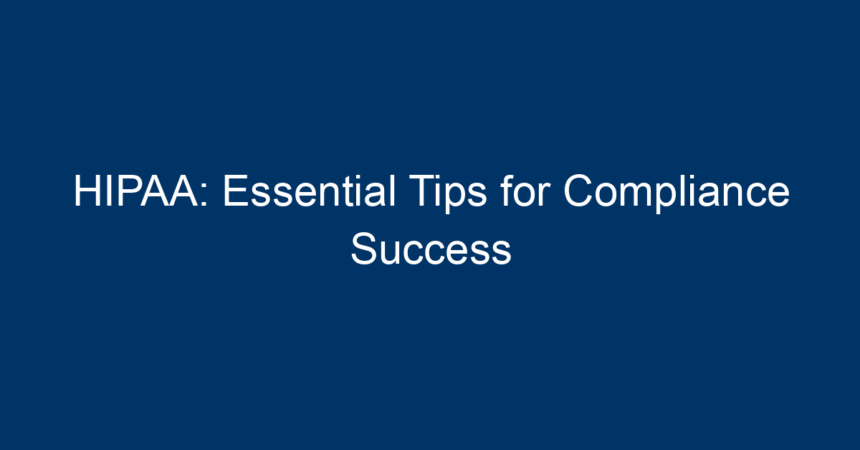In today’s rapidly evolving healthcare landscape, maintaining patient privacy and security is more important than ever. The Health Insurance Portability and Accountability Act (HIPAA) sets the standard for protecting sensitive patient information. Compliance with HIPAA not only safeguards your patients’ data but also shields your organization from potential penalties. This article offers essential tips for achieving compliance success with HIPAA, ensuring that your healthcare practice thrives while fully respecting patient confidentiality.
Understanding HIPAA: The Foundations
What is HIPAA?
HIPAA was enacted in 1996 to protect the privacy and security of healthcare information. It applies to healthcare providers, insurance companies, and any entity that deals with protected health information (PHI). Under HIPAA, certain administrative, physical, and technical safeguards are required to keep patient data secure.
The Importance of HIPAA Compliance
Compliance with HIPAA is not just about following rules; it’s crucial for building patient trust and avoiding hefty fines. Violations can result in fines ranging from $100 to $50,000 per violation, depending on the severity and intent. Moreover, HIPAA compliance fosters a culture of accountability and best practices in healthcare operations.
Essential Tips for HIPAA Compliance Success
1. Conduct a Thorough Risk Assessment
One of the first steps in achieving HIPAA compliance is conducting a comprehensive risk assessment. This should include:
- Identifying PHI: Determine where your organization stores sensitive patient information.
- Analyzing Vulnerabilities: Assess potential risks to the confidentiality, integrity, and availability of PHI.
- Documenting Findings: Keep a detailed record of your assessment for future reference.
By identifying vulnerabilities early on, you can implement measures to mitigate risks before they escalate.
2. Develop Robust Policies and Procedures
Once you have your risk assessment, the next step is to create clear policies and procedures. Effective policy development should include:
- Access Control: Define who has access to PHI and under what circumstances.
- Data Protection: Establish guidelines for handling, sharing, and disposing of patient information.
- Incident Reporting: Develop a clear framework for reporting and responding to data breaches.
By having written procedures in place, you establish a clear expectation for all employees, ensuring that everyone understands their role in maintaining HIPAA compliance.
3. Train Your Workforce
Training is a crucial element in ensuring that all staff members understand HIPAA guidelines and their compliance responsibilities. Consider the following:
- Regular Training Sessions: Schedule recurring training to keep employees informed of any updates in HIPAA regulations or internal policies.
- Role-Specific Training: Tailor training modules to different roles within your organization, as compliance needs may vary by position.
- Testing and Certification: Implement tests or certifications to ensure staff retention of information.
Regular employee training underscores your organization’s commitment to HIPAA compliance and minimizes the risk of unintentional violations.
4. Implement Technical Safeguards
Technology plays a pivotal role in HIPAA compliance. Implementing technical safeguards can significantly enhance data security. Key measures include:
- Encryption: Encrypting PHI during transmission and storage helps protect sensitive data from unauthorized access.
- Secure Access Controls: Use role-based access and strong passwords to limit PHI access to authorized personnel only.
- Audit Logs: Regularly review logs to monitor access and detect any suspicious activity.
By leveraging technology, you can enhance the security of patient data and demonstrate due diligence in maintaining HIPAA compliance.
5. Establish a Data Breach Response Plan
Despite your best efforts, breaches can happen. Having an effective data breach response plan is essential. This plan should include:
- Immediate Actions: Outline steps to contain the breach and limit further exposure.
- Notification Procedures: Detail how and when to notify affected individuals and appropriate authorities, in line with HIPAA’s breach notification rule.
- Post-Incident Analysis: Conduct a review to understand what went wrong and implement measures to prevent similar breaches in the future.
Being prepared for a breach not only helps mitigate damage but also shows your commitment to patient security.
6. Perform Regular Compliance Audits
Regular audits are necessary to ensure ongoing compliance with HIPAA regulations. When conducting audits, focus on:
- Policy Adherence: Ensure staff are following established policies and procedures.
- Risk Assessment Updates: Verify that your risk assessments are current and reflective of the organization’s practices.
- Documentation Review: Confirm that all compliance documentation is up to date and accessible.
By regularly auditing your organization’s HIPAA compliance efforts, you can identify areas for improvement and ensure you remain compliant in an ever-changing regulatory landscape.
Conclusion: Take Actionable Steps Today
Achieving HIPAA compliance may seem daunting, but it is a vital aspect of delivering quality healthcare. By conducting a thorough risk assessment, developing robust policies, training your workforce, leveraging technology, establishing a data breach response plan, and performing regular audits, you can set your organization on a path to compliance success.
In a world where patient privacy is paramount, taking proactive measures to ensure HIPAA compliance not only protects your patients but also enhances your organization’s reputation. Start implementing these essential tips today, and foster a culture of compliance that prioritizes patient confidentiality and trust.
Adhering to HIPAA is not just a legal obligation; it’s a commitment to excellence in healthcare.




